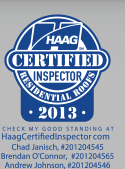Commercial Roofs
There are 8 distinct groups of commercial roofing systems, each group with its own unique quality and performance capabilities. Whether greater energy efficiency or better durability is required―there is a roofing system for your needs! New or Repair we’re here to help.
The 8 distinct groups of commercial roofing systems:
TPO & PVC (thermoplastic single-ply membranes)
Steep Slope Roofs
Predominantly used in residential roofing, steep slope roofs are known for their visual appeal. A wide range of products can be used to enhance the architectural appearance of the property. These products include: cedar shakes, cedar shingles, slate, metal and other options.
Metal Roofs
Contrary to past perception, with the proper insulation, metal roofs can be as quiet as shingle, slate or tile. It is renewable and energy efficient when coated. Metal roofs come in an array of options and can be designed to portray the look of shingles, slate or shakes.
Built-up Roofs (BUR)
Considered as one of the most popular kind of roofing systems used in commercial roofing, BUR is built to withstand adverse weather conditions in extreme climates. Its layered configuration makes it virtually impenetrable to water. With a higher initial investment, built-up roofs are relatively low maintenance, easy to repair and over the life span of the roof it is arguably inexpensive.
Modified Bitumen
Modified Bitumen is a result of additives being applied to asphalt as modifiers to emphasize the characteristics of plastic or rubber. Modified Bitumen is applied to sheets of polyester, fiberglass or composite and a wide range of materials can be applied to the surface. These materials such as mineral granules, gravel and roof coatings help protect the roof from the harmful effects of ultra violet rays―it is similar to built-up roofs in that it is applied in layers.
Polyurethane Foam
If a seamless water tight roofing system is the goal, polyurethane foam serves that purpose. It forms a barrier around pipes, vents and edges preventing water from leaking through and when built up in ponding areas water is diverted off the roof. It’s method of application as a spray makes it easy to install. With proper maintenance this type of roof should last the entire life-cycle of the building.
TPO & PVC (Thermoplastic Single-Ply Membranes)
In the past decade, TPO & PVC have risen in popularity and has become the staple of sustainable building. Their white surface allows for the optimal repulsion of heat and superior reflection of the sun’s rays. They are also very economical when compared to built-up roofing systems. These qualities make TPO & PVC the prime choice when an energy efficient, low cost roofing system is required.
TPO
More cost effective than PVC and when compared to EPDM rubber roofs, a greater resistance to puncture and greater durability is achieved. When exposed to chemicals and grease this membrane does exhibit resistance.
PVC
When compared to all other Single-Ply membranes, PVC is the most durable of them all and with the addition of Elvaloy―PVC becomes resistant to chemicals and grease.
EPDM (Thermoset Single-Ply Membranes)
Made from rubber polymers EPDM is produced in a factory and is subjected to strict performance tests. EPDM rubber roofs will withstand the weathering process and holds up to varying temperatures. Available in wider sheets, easy installation is achieved and fewer seams are created to decrease the chance of water penetration.
Roof Coatings
Roof coatings come in a number of forms such as acrylic, silicone, butyl etc. These liquid products are used in the restoration of metal, modified bitumen, built-up, thermoset single-ply membrane and thermoplastic single-ply membrane roofs. Not only are roof coatings used to extend the life of flat roofs, they can also be used in the restoration of steep slope roofs.









